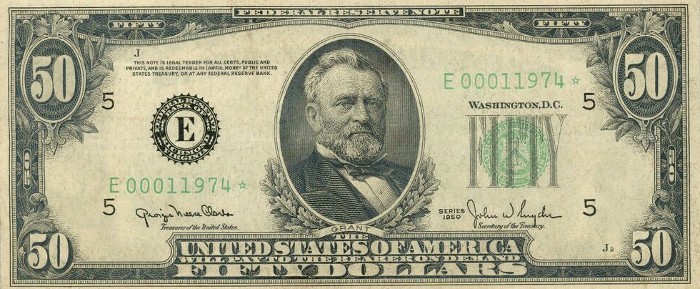The 1950 fifty dollar bills can be valuable depending on the series. Star notes can be worth more than the standard notes. Continue reading to learn more about these bills.

Specifications
| Denomination: | $50.00 USD |
| Type: | Federal Reserve Note |
| Portrait: | Ulysses S. Grant |
| Series: | Six: 1950, 1950A, 1950B, 1950C, 1950D, 1950E |
Value
Most of the 1950 $50 bills are only worth their face value of $50 in circulated condition.
Below are the general values for each series in very fine condition and MS 63 uncirculated condition.
| Series | Very Fine | MS 63 Uncirculated |
|---|---|---|
| 1950 | $75 | $125-150 |
| 1950A | $60 | $125 |
| 1950B | $55-65 | $125-150 |
| 1950C | $60-70 | $145-175 |
| 1950D | $60-65 | $125-150 |
| 1950E | $90-95 | $275-350 |
Star Notes
Star notes are replacement bills that the United States Federal Reserve printed. These star notes are more rare and thus more valuable. You can tell if you have a star note by looking to see if there is a star symbol at the end of the serial number.
Below are the general values for each star note series in very fine condition and MS 63 uncirculated condition.
| Series | Very Fine | MS 63 Uncirculated |
|---|---|---|
| 1950 | $150 | $900-975 |
| 1950A | $75-100 | $325-375 |
| 1950B | $100-110 | $300-400 |
| 1950C | $90-100 | $275-375 |
| 1950D | $125-150 | $450-500 |
| 1950E | $250-300 | $1,000-1,250 |
Note: Valuable bills should be placed inside currency holders.
Grading System
Very fine- A note that has been in circulation but not for a long time. The note is still relatively crisp. There may be some creases, folds, or light smudges.
MS 63 choice uncirculated- A note that shows no signs of ever having been in circulation. The note still has its original crispness. The note is also well-centered.
Sources:
A Guide Book of United States Paper Money
See also:
